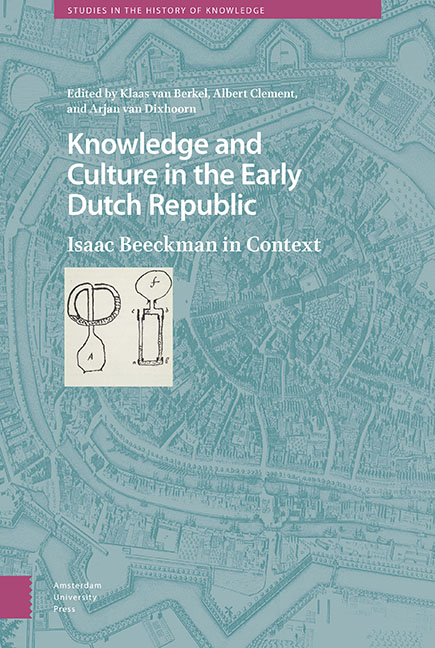17 - ‘Ut patet in figura’: On the Use of Images in Beeckman’s Journal
Published online by Cambridge University Press: 07 October 2022
Summary
Abstract
Isaac Beeckman's notebook includes some 240 drawings made by Beeckman himself, but thus far no attention has been paid to them. Most of these drawings are indeed illustrations that support the argument in the text of the notebook, but in a couple of cases the drawings do more than that and replace the argument; they do not illustrate the text, but are the argument itself, the text serving as illustration to the picture. These pictures document Beeckman's visual way of thinking and reveal that his mechanical philosophy is in part the product of a realistic interpretation of illustrations found in the work of Simon Stevin, especially his picture of the clootcrans, or wreath of spheres.
Keywords: Isaac Beeckman, drawings, pictorial argument, Simon Stevin, wreath of spheres
Isaac Beeckman included around 240 images of his own making in his Journal. In addition, there are some musical scores and images taken from books studied or referred to by Beeckman and inserted in the Journal by its editor, Cornelis de Waard. In itself, the number of 240 images is not excessively high. The printed Journal has some 1,270 pages, so, on average, there is an image on every fifth page of the book. Nevertheless, it is a substantial number, and it is therefore strange that Beeckman's images have not been the subject of scholarly study before. All the more so since we know that Beeckman himself had a strong preference for Anschaulichkeit (picturability), both in the context of discovery and in the context of the dissemination of natural philosophical ideas. Beeckman only accepted explanations that could be represented by a real or mental image. Until the 1980s, historians of science in general were inclined to overlook the presence of images in texts and manuscripts. Since then, however, the importance of these visual tools has become widely recognized. It is therefore about time to ask what kind of images Beeckman used in his notebook, what these images were used for and, most importantly of all, what they tell us about the development of his mechanical philosophy. I will argue that these images are not merely illustrations of the text, but form an integral part of the argument that Beeckman wishes to make.
- Type
- Chapter
- Information
- Knowledge and Culture in the Early Dutch RepublicIsaac Beeckman in Context, pp. 451 - 470Publisher: Amsterdam University PressPrint publication year: 2022



